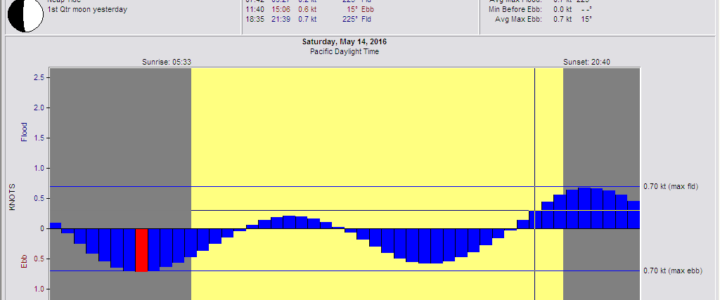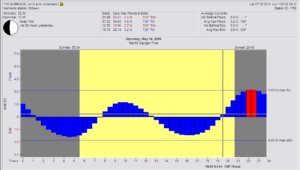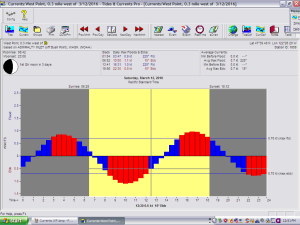What a challenge this has been for the weather forecasters this week with none of the models coming into agreement about what is going to happen this weekend. The latest problem is that there is a new low pressure system that has formed off of the north end of Vancouver Island. It’s weak and not going to last very long, just long enough to make things interesting on Swiftsure. Its attached frontal system will drag across the NW on Saturday with the post frontal system taking a while to set up.
The good news is that we have an ebb tide for the start and a fairly good southeasterly breeze which will at least get us out of the starting area and through Race Passage at a fairly good clip. By 1100 to 1200 things will start to deteriorate as the front will have passed and the breeze ( what there is left of it) will start to get squirelly. Some models have it evaporating in the mid-Straits and staying that way until after midnight. One model has the wind evaporating at 1200 in the mid-Straits but then filling in from the west at 4-6 knots at around 1700 hours which would at least give you some light air beating out to the mark. Once you round the mark it will be a race to see who can get back down the Straits and into more wind. It won’t build from the west however the wind will increase in velocity the further down the Straits you get.
Then there are those pesky tides.
0750 Slack
1228 Max Ebb 4.0 knots
1416 Slack
1922 Max Flood 4.5 knots
2248 Slack
0225 Max Ebb 4.1
0706 Slack
0816 Max Flood .3 knots
0950 Slack
1337 Max Ebb 3.5
1715 Slack
2019 Max Flood 4.0
2334 Slack
As I said, getting out won’t be a problem. It will be getting back that will be interesting with the combination of light air and LOTS of ebb. As you can see, on Sunday morning you have a very small window 0700 to 1000 hrs to get back before the ebb starts rolling again. The later you are coming down the Straits, the more wind you are likely to have so you can work the beach as you approach the Race and then just fight it out.
The keys to this year’s race will be making the most of the east-southeasterly at the start, then sailing rhumb line towards the mouth of the Straits. As the wind begins to clock in the mid-afternoon, work to the south of the rhumb line to be in a position to pick up the incoming westerly. It’s here that the real separation will occur in the fleet as the boats with the best drivers and the best trimmers will move to the front of the fleet. It won’t be easy but hard work will pay big dividends. Have the barber haulers ready and be prepared to go back and forth between the genoa (or wind seeker) and the kite. Weight to leeward or as we say, “All dogs in the house!” The night fighters will make out as trimming going downwind at night is tough. Navigators will have to keep you on the favored board and be using the 7×50 bino’s to keep you in the breeze.
Naviguessors will also have to be logging wind reports as well as the pressure readings to try and get a feel about just how fast the high pressure will be returning and with it, the westerly. Boats with the Starpath ultra sensitive barometer will benefit.
Be safe, have a great race and with any kind of luck I’ll have a post race summary for you on Tuesday.
Ed. Note: Thanks again Bruce. To our readers, please share the info and get people to visit the site! Thanks.
Bruce has raced and cruised the Pacific Northwest his entire life. He earned a Bachelor’s of Science from the University of Washington in Biological Oceanography and learned meteorology “to keep from getting kicked around on the race course.” Bruce spent nearly two decades as Associate Publisher for Northwest Yachting Magazine, retiring in mid-2015, and was the chairman of the board of trustees for the Northwest Marine Trade Association in 2014. (photo of Bruce driving Playstation is a bit dated, but cool)



















































































 The tide will be at near max ebb in the starting area so don’t get caught below the line trying to beat back up with a tide trying to push you to north and your entire fleet reaching over the top of you giving you a massive dose of dirty air.
The tide will be at near max ebb in the starting area so don’t get caught below the line trying to beat back up with a tide trying to push you to north and your entire fleet reaching over the top of you giving you a massive dose of dirty air.









